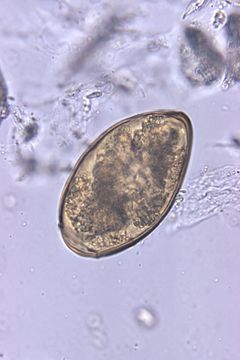Image de Paragonimus westermanni

Description :
Magnified 500X, this photomicrograph of an unstained, formalin-preserved stool specimen mount, revealed the presence of a Paragonimus westermani termatode egg. See PHIL 3415 for the depiction of the following life cycle.
The eggs are excreted unembryonated in the sputum, or alternately they are swallowed and passed with stool (1). In the external environment, the eggs become embryonated (2), and miracidia hatch and seek the first intermediate host, a snail, and penetrate its soft tissues (3). Miracidia go through several developmental stages inside the snail (4): sporocysts (4a), rediae (4b), with the latter giving rise to many cercariae (4c), which emerge from the snail. The cercariae invade the second intermediate host, a crustacean such as a crab or crayfish, where they encyst and become metacercariae. This is the infective stage for the mammalian host (5).
Created: 1973
Inclus dans les pages suivantes :
- Paragonimus westermanni
- Eukaryota (eucaryotes)
- Opisthokonta
- Metazoa (animaux)
- Bilateria
- Protostomia
- Platyhelminthes (Plathelminthes)
- Trematoda
- Digenea
- Plagiorchiida
- Paragonimidae
- Paragonimus
- Life
- Cellular (Organismes cellulaires)
- Spiralia
- Neodermata
Cette image ne figure dans aucune collection.
Informations sur la provenance
- licence
- cc-publicdomain
- fournisseur
- Public Health Image Library
- original
- fichier de média d’origine
- visiter la source
- site partenaire
- Public Health Image Library
- ID


